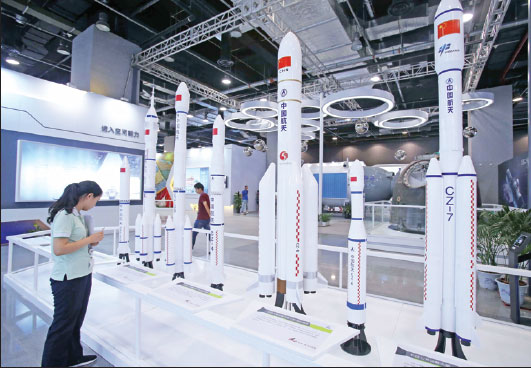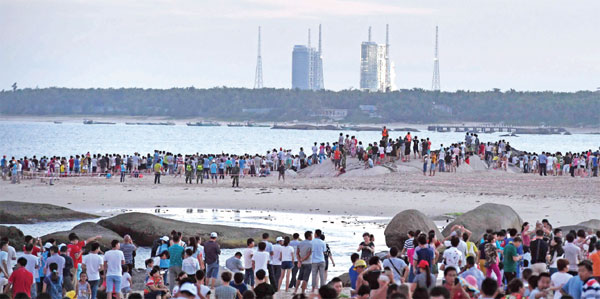Rocket scientists reach for the sky
Updated: 2016-10-07 07:41
By Zhao Lei(China Daily)
|
|||||||||
Hard work on the ground ensures dream of success can take flight
Deng Xinyu, 32, has lived in Beijing since 2002 when he left his hometown of Huaihua in Hunan province, and moved to the capital to enter university.
In common with most of the capital's residents, he talks about the soaring cost of property, traffic and good restaurants. He likes movies and reading books on history.
But his main focus is out of this world, literally. Most of his energy and attention is devoted to one big thing - the Long March 7, China's newest and most powerful space rocket.
Deng, the father of a 3-year-old boy, is a senior engineer in the Long March 7 project team at the China Academy of Launch Vehicle Technology, the major developer of these rockets.
"Though the rocket's first flight was successful, we are not complacent. Actually, we are busy preparing for its second mission," Deng told China Daily.

"Because the Long March 7 is a brand new model, it is totally different from previous types so our design methods and difficulties were different."
China conducted the maiden launch of the Long March 7 on June 25 at the Wenchang Space Launch Center in the island province of Hainan. The rocket sent seven payloads, including a model of China's next-generation manned spacecraft and a space debris cleaner, into orbit.
Propelled by pollution-free fuel, the Long March 7 is capable of sending 13.5 tons of payload into low Earth orbit and 5.5 tons into a sun-synchronous orbit. With a take-off weight of 597 metric tons, it is currently the most powerful rocket in China's launch vehicle family as its payload capability is about 1.5 times bigger than that of the Long March 2F, the predecessor to the Long March 7, according to the China Academy of Launch Vehicle Technology.
"The capabilities of a nation's rockets determine the extent of its space activity," Deng said. Researchers at his academy, he added, are mostly in their 30s and they are committed to ensuring China realizes its space aspirations.
"I arrive in the office at 8 am every day and go home at about 8:30 pm. I also work at least one day over the weekend. Usually, I have only one supper with my family each week," he told China Daily.
"But I don't regret choosing this job and I am still energetic. This is because my job keeps bringing me new challenges and inspiration."
Over the past two decades, the world witnessed China's rise from a mediocre space player to an influential power. It has sent 10 spacecraft and 10 astronauts into space and will soon fulfill a new manned mission to transport two astronauts to a space laboratory.
The nation has also made three lunar exploration missions, including one that soft-landed a rover on the moon.
Currently, Chinese scientists and engineers are developing a permanent manned space station, which is set to be built in space from 2018 and will be put into service around 2022.
It is expected to become the world's only space station after the International Space Station is retired in 2024.
The country will also send an unmanned probe to Mars to orbit and land on the Red Planet around 2020, Chinese space authorities said.
Furthermore, Lieutenant General Zhang Yulin, deputy head of the Central Military Commission's Equipment Development Department, said in April that China will land astronauts on the moon in 15-20 years.
These ambitious plans to send manned craft into space require massive work on the ground and teams of researchers in institutes, like the China Academy of Launch Vehicle Technology, are racing against time.
Ma Ying, 38, another senior engineer in the Long March 7 team and a leader of a sub-team, said, "every month, there are always some people in my office that are on business trips. Everyone in the office must be 'multifunctional' so they are able to handle various tasks."
He said overtime is common but no one has complained.
"We bond with each other because we all understand one person's mistake will affect others' work. We believe in team spirit," the engineer explained.
To support the rapid growth in the nation's space activities, China Aerospace Science and Technology Corp, which runs the rocket academy, began to expand its workforce several years ago.
The State-owned giant employed more than 5,300 university graduates in 2012, around 4,000 in 2013 and around 3,000 each year since 2014.
Ma noted that in the past, newcomers to the academy would have a certain period of time to get used to their tight schedules, but now most new recruits have to fit quickly into the fast-paced agenda from their first day.
According to Ma, about 30 percent in his sub-team are women but they are far removed from what may be the public's perception of female scientists. Just like women and men in other fields, they have various interests and hobbies but their commitment to the project is total.
"My female colleagues are devoted and dedicated to the work but they also pursue a quality life and maintain a good work-life balance."
These young female rocket designers are like Ma's sisters, he said, and in the rare moments that they have some time off, they like to socialize. "They often ask me to organize a party for the sub-team and of course, that I should pay the bill," he laughed.
Chen Rong, 33, a researcher on future launch vehicles at the academy, said she took part in the Long March 7's first mission. She recalls it was an exciting and memorable time.
"I was responsible for transmitting track information from the ground control center in Beijing to my colleagues in Wenchang during the launch process, and each second of that time was breathtaking and exciting," she recalled.
It was not uncommon for Chen and her husband, also a researcher at the academy, to be both busy so they ask their parents to take care of their 2-year-old daughter.
Moreover, Chen said she often worries about the schooling of her little girl.
"Nevertheless I am optimistic. China's space programs have great plans and bright prospects, so do we," she said.
"We will realize existing plans on schedule and resolve problems one by one. Meanwhile we will explore new fields. This approach applies to both the rocket development as well as my family's growth."
Before the end of this year, the latest product of the China Academy of Launch Vehicle Technology - the Long March 5 heavy-lift rocket, will conduct its maiden flight from the Wenchang center.
Boasting a take-off weight of 869 tons, it can lift a 25-ton payload into low orbit or a 14-ton payload into geosynchronous transfer orbit.
The Long March 5 will be tasked with launching China's heavyweight spacecraft including the Chang'e 5 lunar probe, core module of the planned space station and Mars probes, according to the China Aerospace Science and Technology Corp.
The company has also begun to develop a super-heavy rocket that will have a take-off weight of 3,000 tons and can thrust a 100-ton payload into low orbit, Yang Baohua, deputy general manager of the company, previously told reporters.
He noted that the gigantic rocket will be twice as tall and seven times more powerful than the Long March 7.
If the research and development proceed well, the super-heavy rocket will carry out its first flight around 2030, and then it will enable China to carry out manned missions to the moon and to send and retrieve Mars probes, he said.
Talking about the prospect of China's space programs, Yao Guowei, a development planner at the rocket academy, said he hopes that the nation's space industry could make more efforts to bolster creativity and innovation.
He also suggests that the industry should encourage more participation from the private sector and pay due consideration to the commercial aspect of the space market.
Major Long March rockets in service
Long March 2C
Blast-off date: September 1982. Mainly used to launch satellites into low and sun-synchronous orbit.
Long March 2F: November 1999. Primarily to launch Shenzhou manned spacecraft and Tiangong space laboratories.
Long March 3B: August 1997. Mostly to launch satellites into geostationary transfer orbit.
Long March 4B: May 1999. To place satellites into sun-synchronous orbit.
Long March 6: September 2015. Again, mostly to place satellites in sun-synchronous orbit.
Long March 7: June 2016. This rocket will be used for nearly 80 percent of China's space launches in the future.
China's manned space activities:
Shenzhou V mission: Launched on Oct 15, 2003, lasting 21 hours. China's first manned space mission.
Shenzhou VI mission: Launched on Oct 12, 2005, lasting nearly 5 days.
Shenzhou VII mission: Launched on Sept 25, 2008, lasting nearly 3 days. China's first extra-vehicular mission.
Tiangong I mission: Launched on Sept 29, 2011, lasting more than two years. China's first space laboratory.
Shenzhou IX mission: Launched on June 16, 2012, lasting nearly 13 days. China's first space docking.
Shenzhou X mission: Launched on June 11, 2013, lasting nearly 15 days. The longest stay in space by Chinese astronauts.
Tiangong II mission: Launched on Sept 15, 2016, will last two years. China's second space laboratory.
zhaolei@chinadaily.com.cn
|
Models of rockets from the Long March series are on display at an aviation technology exhibition in Beijing on Sept 18. Chen Xiaogen / For China Daily |
|
Spectators gather to witness the launch of Long March 7 at the Wenchang Launch Center in Hainan province on June 25. Huang Yibing / For China Daily |
(China Daily 10/07/2016 page1)
Today's Top News
Pound plunges 6% in Asian trade on Brexit fear
Public holidays a profitable industry
Theresa May shifts her party toward the center
Security Council agrees on Guterres as next UN chief
Rudd says immigration speech not racist
West may be best for nation's teenagers
Trio wins Nobel chemistry prize for 'nano machines'
IMF sees Brexit damage to British growth
Hot Topics
Lunar probe , China growth forecasts, Emission rules get tougher, China seen through 'colored lens', International board,
Editor's Picks

|

|

|

|

|

|









